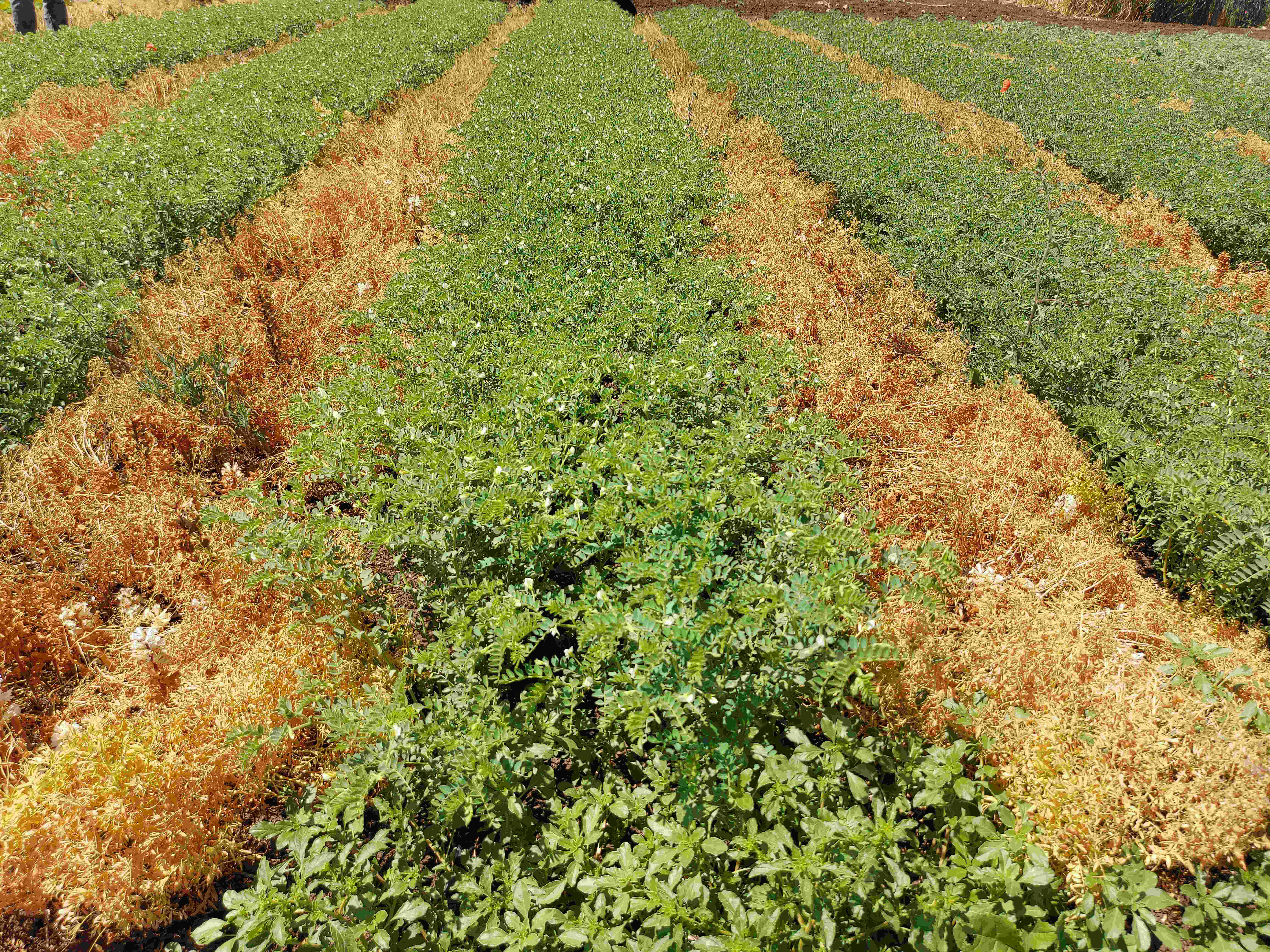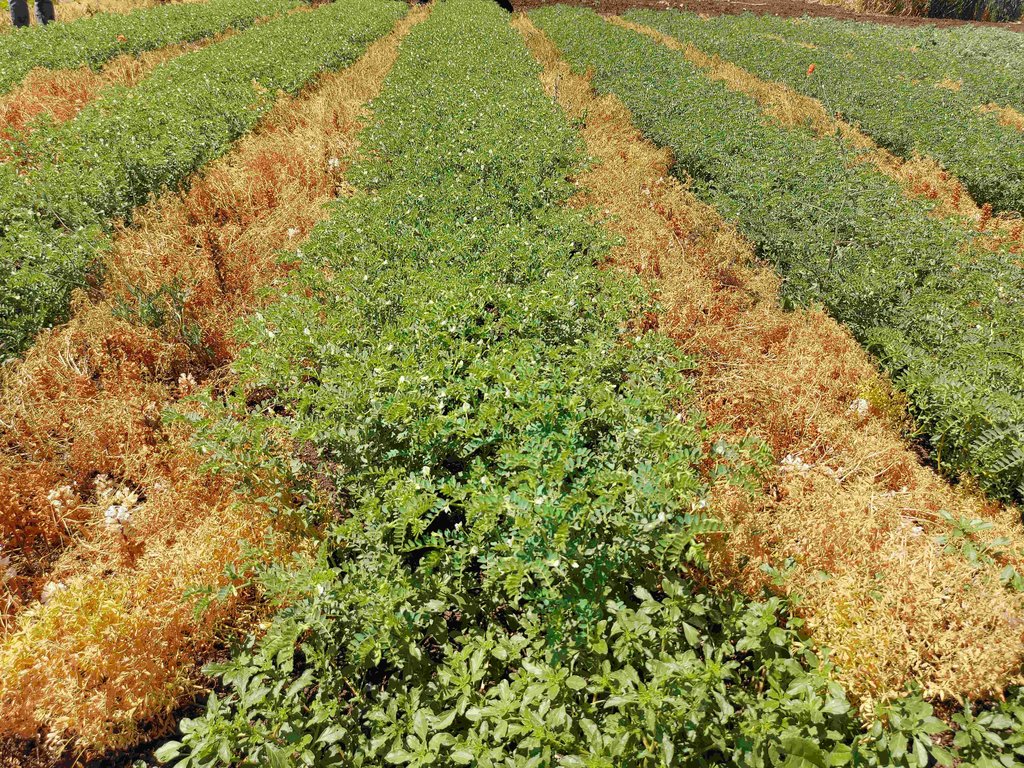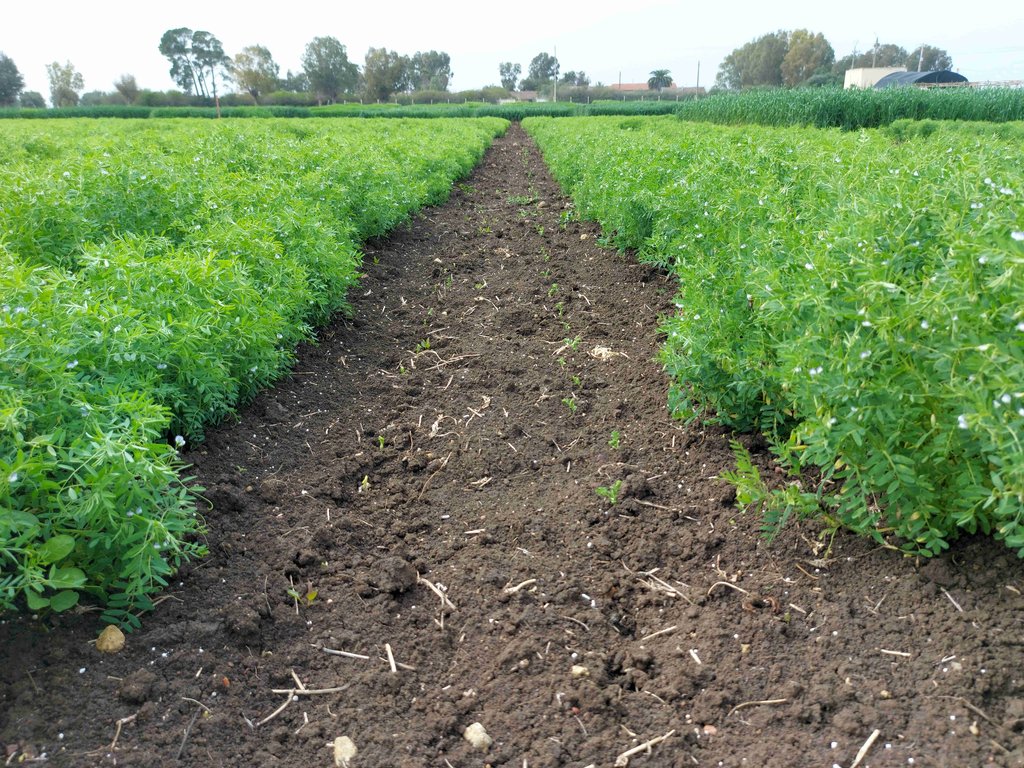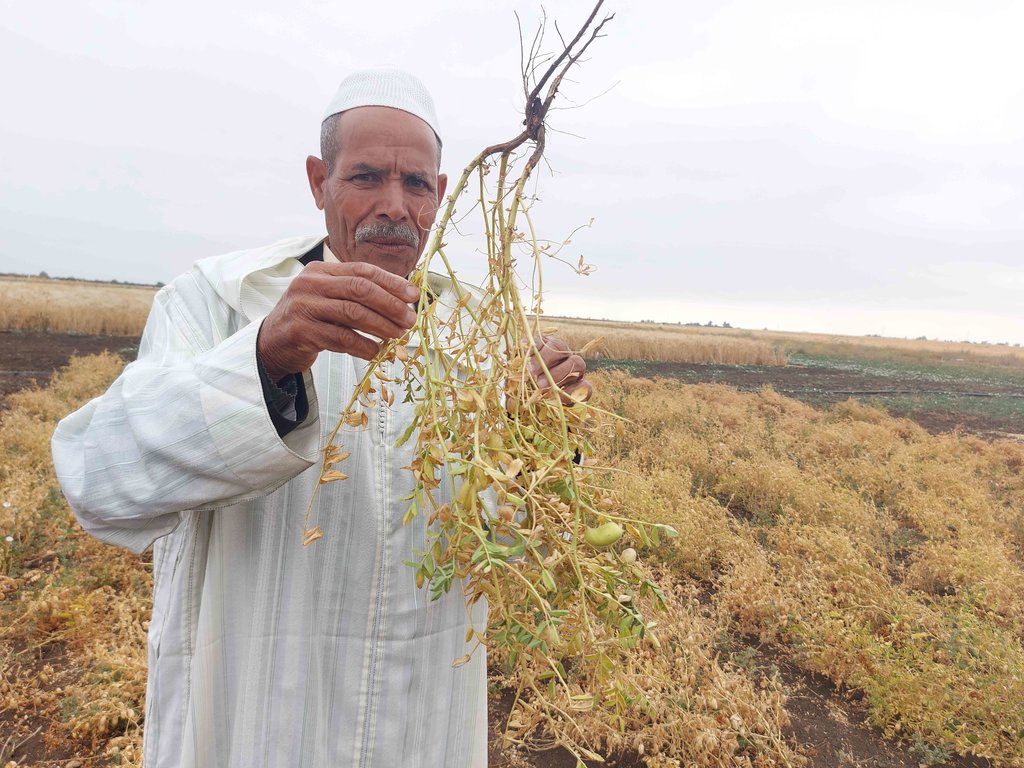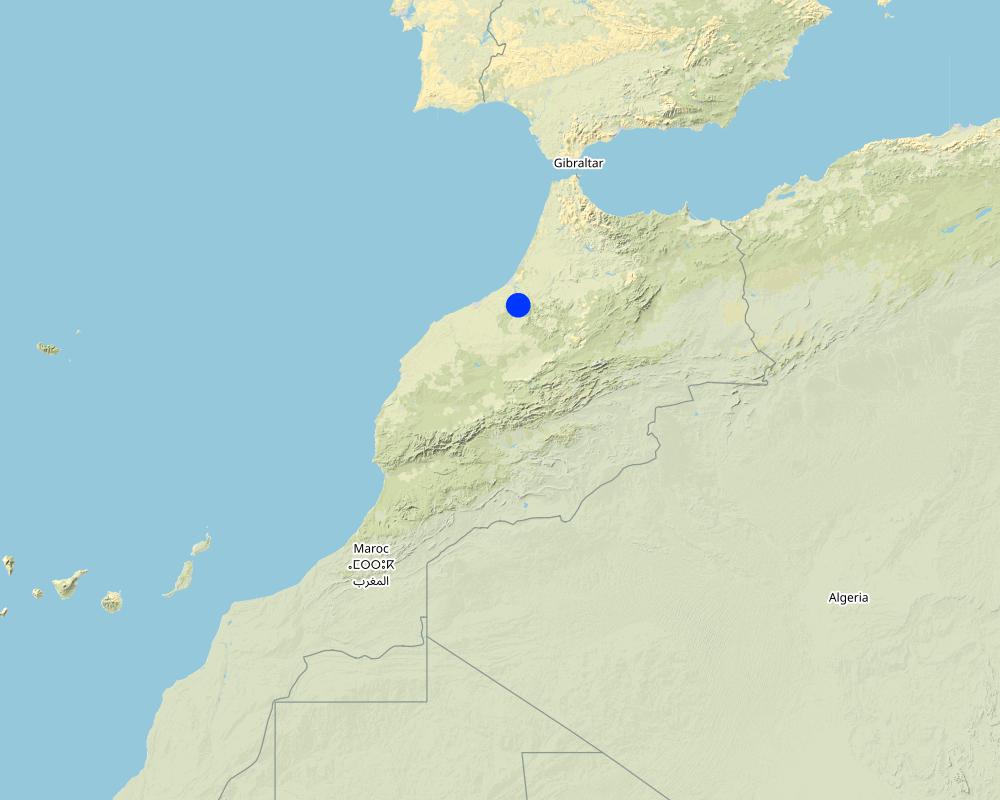Diversified Cropping System: Relay Intercropping of Lentils with Chickpeas [摩洛哥]
- 创建:
- 更新:
- 编制者: Fatma Rekik
- 编辑者: Joren Verbist
- 审查者: William Critchley, Rima Mekdaschi Studer
technologies_6416 - 摩洛哥
查看章节
全部展开 全部收起1. 一般信息
1.2 参与该技术评估和文件编制的资源人员和机构的联系方式
关键资源人
Agronomist:
Devkota Mina
International Center of Agriculture Research in the Dry Areas (ICARDA)
摩洛哥
Research Team Leader - Soils, Waters and Agronomy:
Vinay Nangia
International Center of Agriculture Research in the Dry Areas (ICARDA)
摩洛哥
有助于对技术进行记录/评估的项目名称(如相关)
ICARDA Institutional Knowledge Management Initiative有助于对技术进行记录/评估的机构名称(如相关)
International Center for Agricultural Research in the Dry Areas (ICARDA) - 黎巴嫩1.3 关于使用通过WOCAT记录的数据的条件
编制者和关键资源人员接受有关使用通过WOCAT记录数据的条件。:
是
1.4 所述技术的可持续性声明
这里所描述的技术在土地退化方面是否存在问题,导致无法被认为是一种可持续的土地管理技术?:
否
2. SLM技术的说明
2.1 技术简介
技术定义:
A Diversified Cropping System (DCS) results in a more resilient and productive cropping system. In this case, chickpeas were introduced as a relay intercrop between established lines of lentils. This not only had no negative effect on lentil yields, but also enabled the harvest of an extra crop: chickpeas.
2.2 技术的详细说明
说明:
In the semi-arid regions of Morocco, agricultural production varies from year to year, but yields are generally declining because of climate change. Climate change is leading to more irregular rainfall and frequent extreme weather events. Wherever possible, there is a need to intensify agricultural systems to ensure food security while simultaneously increasing resilience.
Cultivating lentils (Lens culinaris) as a sole crop is common practice in rural Morocco. To intensify this cropping system, the International Centre for Agricultural Research Dry Areas (ICARDA) introduced chickpeas (Cicer arietinum) as a relay intercrop into the common lentil production system. Because chickpeas are planted within an already growing crop of lentils, this form of intercropping is termed "relay planting". Importantly, chickpeas do not affect the yields of lentils (0.837 + 0.19 t ha-1 yield in sole vs. 0.808 + 0.159 t ha-1 in intercrop) because they do not significantly compete for water and nutrients. With two crops harvested from the same piece of land, overall farm profits increase. Furthermore, this creates a more resilient production system because the farmer is not dependent on a single crop. Additionally, including chickpeas as a relay-intercrop extends the cropping season and prolongs the period where the soil is covered, consequently protecting it from degradation. An added advantage is that both chickpeas and lentils are leguminous, nitrogen-fixing crops that can improve soil fertility. Also, both crops have high cultural and culinary value locally. However, the technology has potential drawbacks as in years of extreme droughts, chickpeas require supplementary irrigation, especially during establishment. This is often unavailable to local farmers and may result in poor crop establishment and low yields.
In 2020-2022, ICARDA tested this Diversified Cropping System (DCS) on a trial field of half a hectare, in an area with average annual precipitation of 390 mm (based on 40 years of data). The system is implemented as follows. First, the field is prepared by ploughing. In December, lentils are mechanically seeded. Two rows of lentils are planted 15 cm apart. The spacing between each two-row pair is roughly 90 cm. Compound fertilizer is applied during seeding. In January, an herbicide is sprayed to control grassy weeds. The field is mechanically weeded twice, in mid-January and then again in February. Chickpeas are sown at the end of February also in paired lines (two rows 20 cm apart) also with compound fertilizer. Each pair of chickpea lines is planted between pairs of lentils. In March, the plots are manually weeded, and in April, the lentils are manually harvested and mechanically threshed. A single spray of insecticide is applied in April-May. Finally, in June, the chickpeas are mechanically harvested and have an average yield of 1.1 + 0.146 t ha-1.
This documentation illustrates an ICARDA innovation that is accessible since there are no establishment events and costs. This Diversified Cropping System improves a traditional system by introducing an additional crop, resulting in higher farm income and resilience to variable weather.
2.3 技术照片
2.5 已应用该技术的、本评估所涵盖的国家/地区/地点
国家:
摩洛哥
区域/州/省:
Khémisset Province
有关地点的进一步说明:
Merchouch
具体说明该技术的分布:
- 适用于特定场所/集中在较小区域
技术现场是否位于永久保护区?:
否
Map
×2.6 实施日期
注明实施年份:
2021
2.7 技术介绍
详细说明该技术是如何引入的:
- 在实验/研究期间
3. SLM技术的分类
3.1 该技术的主要目的
- 改良生产
- 适应气候变化/极端天气及其影响
- 创造有益的经济影响
3.2 应用该技术的当前土地利用类型
同一土地单元内混合使用的土地::
否

农田
- 一年一作
年作 - 具体指明作物:
- legumes and pulses - lentils
- chickpeas
每年的生长季节数:
- 1
采用间作制度了吗?:
是
如果是,说明哪些作物是间作的:
Chickpeas
采用轮作制度了吗?:
否
3.3 由于技术的实施,土地使用是否发生了变化?
由于技术的实施,土地使用是否发生了变化?:
- 否(继续问题3.4)
3.4 供水
该技术所应用土地的供水:
- 雨养
注释:
By default, it is rainfed, unless there are droughts, in which case supplementary irrigation is introduced.
3.5 该技术所属的SLM组
- 改良的地面/植被覆盖
3.6 包含该技术的可持续土地管理措施

农艺措施
- A1:植被和土壤覆盖层

管理措施
- M2:改变管理/强度级别
- M4:活动时间安排的重大变化
3.7 该技术强调的主要土地退化类型

土壤水蚀
- Wt:表土流失/地表侵蚀

土壤风蚀
- Et:表土流失
3.8 防止、减少或恢复土地退化
具体数量名该技术与土地退化有关的目标:
- 减少土地退化
4. 技术规范、实施活动、投入和成本
4.1 该技术的技术图纸
技术规范(与技术图纸相关):
The symbols correspond to the following technical specifications:
A: Spacing between a row of lentil and a row of chickpea= 35 centimetres
B: Spacing between two rows of lentil in the same pair = 15 centimetres
C: Spacing between two rows of chickpea in the same pair = 20 centimetres
D: Spacing between two rows of lentil bordering a pair of chickpea= 90 - 95 centimetres
作者:
Fatma Rekik
日期:
05/09/2022
4.2 有关投入和成本计算的一般信息
具体说明成本和投入是如何计算的:
- 每个技术区域
注明尺寸和面积单位:
1 Hectare
其它/国家货币(具体说明):
Moroccan Dirham
如相关,注明美元与当地货币的汇率(例如1美元=79.9巴西雷亚尔):1美元=:
10.63
注明雇用劳工的每日平均工资成本:
75
4.3 技术建立活动
注释:
Chickepeas and lentils are annuals and they are cropped once a year under the conditions in question. As such, the above activities are listed under establishment (because they are only done once for every cropping season)
4.5 维护/经常性活动
| 活动 | 时间/频率 | |
|---|---|---|
| 1. | Field Ploughing | Prior to seeding |
| 2. | Lentil Seeding | December |
| 3. | Fertilizer Application (Lentil) | During seeding |
| 4. | Herbicide Application (Lentil) | January |
| 5. | First Mechanical Weeding (Lentil) | Mid January |
| 6. | Second Mechanical Weeding (Lentil) | Mid February |
| 7. | Chickpea Seeding | End of February |
| 8. | Fertilizer Application (Chickpea) | During seeding |
| 9. | Fungicide Application (Lentil) | February-March |
| 10. | Manual Weeding (Chickpea) | March |
| 11. | Lentil Harvesting | April |
| 12. | Insecticide Application (Chickpea) | April-May |
| 13. | Chickpea Harvesting | June |
注释:
The above activities are listed under recurrent because they are done more than once throughout the cropping season (and according to the need).
4.6 维护/经常性活动所需要的费用和投入(每年)
| 对投入进行具体说明 | 单位 | 数量 | 单位成本 | 每项投入的总成本 | 土地使用者承担的成本% | |
|---|---|---|---|---|---|---|
| 劳动力 | Weeding (Lentil) | Person-Days | 10.0 | 75.0 | 750.0 | 100.0 |
| 劳动力 | Weeding (Chickpea) | Person-Days | 10.0 | 75.0 | 750.0 | 100.0 |
| 劳动力 | Lentil Harvesting | Person-Days | 10.0 | 75.0 | 750.0 | 100.0 |
| 设备 | Plough | Machine-Hours | 3.0 | 150.0 | 450.0 | 100.0 |
| 设备 | Lentil Seeder | Machine-Hours | 1.0 | 150.0 | 150.0 | 100.0 |
| 设备 | Chickpea Seeder | Machine-Hours | 1.0 | 200.0 | 200.0 | 100.0 |
| 设备 | Sprayer | Machine-Hours | 3.0 | 60.0 | 180.0 | 100.0 |
| 设备 | Weeder | Machine-Hours | 2.0 | 100.0 | 200.0 | 100.0 |
| 设备 | Lentil Thresher | Machine-Hours | 2.0 | 150.0 | 300.0 | 100.0 |
| 设备 | Chickpea harvester | Machine-Hours | 2.5 | 300.0 | 750.0 | 100.0 |
| 植物材料 | Lentil seeds | Kilogram | 45.0 | 8.0 | 360.0 | 100.0 |
| 植物材料 | Chickpea seeds | Kilogram | 80.0 | 15.0 | 1200.0 | 100.0 |
| 肥料和杀菌剂 | Herbicide (for Lentil) | Litre | 1.0 | 170.0 | 170.0 | 100.0 |
| 肥料和杀菌剂 | Insecticide (for Chickpea) | Litre | 0.25 | 300.0 | 75.0 | 100.0 |
| 肥料和杀菌剂 | Fungicide (for Lentil) | Litre | 0.5 | 150.0 | 75.0 | 100.0 |
| 肥料和杀菌剂 | NPK 10:20:20 (for Lentil) | Kilogram | 100.0 | 3.0 | 300.0 | 100.0 |
| 肥料和杀菌剂 | NPK 10:20:20 (for Chickpea) | Kilogram | 100.0 | 3.0 | 300.0 | 100.0 |
| 技术维护所需总成本 | 6960.0 | |||||
| 技术维护总成本,美元 | 654.75 | |||||
5. 自然和人文环境
5.1 气候
年降雨量
- < 250毫米
- 251-500毫米
- 501-750毫米
- 751-1,000毫米
- 1,001-1,500毫米
- 1,501-2,000毫米
- 2,001-3,000毫米
- 3,001-4,000毫米
- > 4,000毫米
指定年平均降雨量(若已知),单位为mm:
390.00
有关降雨的规范/注释:
typical Mediterranean climate with winter rains
注明所考虑的参考气象站名称:
INRA + ICARDA weather data
农业气候带
- 半干旱
5.2 地形
平均坡度:
- 水平(0-2%)
- 缓降(3-5%)
- 平缓(6-10%)
- 滚坡(11-15%)
- 崎岖(16-30%)
- 陡峭(31-60%)
- 非常陡峭(>60%)
地形:
- 高原/平原
- 山脊
- 山坡
- 山地斜坡
- 麓坡
- 谷底
垂直分布带:
- 0-100 m a.s.l.
- 101-500 m a.s.l.
- 501-1,000 m a.s.l.
- 1,001-1,500 m a.s.l.
- 1,501-2,000 m a.s.l.
- 2,001-2,500 m a.s.l.
- 2,501-3,000 m a.s.l.
- 3,001-4,000 m a.s.l.
- > 4,000 m a.s.l.
说明该技术是否专门应用于:
- 不相关
5.3 土壤
平均土层深度:
- 非常浅(0-20厘米)
- 浅(21-50厘米)
- 中等深度(51-80厘米)
- 深(81-120厘米)
- 非常深(> 120厘米)
土壤质地(表土):
- 中粒(壤土、粉土)
土壤质地(地表以下> 20厘米):
- 中粒(壤土、粉土)
表土有机质:
- 中(1-3%)
5.4 水资源可用性和质量
地下水位表:
5-50米
地表水的可用性:
匮乏/没有
水质(未处理):
不良饮用水(需要处理)
水质请参考::
地下水
水的盐度有问题吗?:
否
该区域正在发生洪水吗?:
否
5.5 生物多样性
物种多样性:
- 低
栖息地多样性:
- 低
5.6 应用该技术的土地使用者的特征
定栖或游牧:
- 定栖的
生产系统的市场定位:
- 混合(生计/商业)
非农收入:
- 低于全部收入的10%
相对财富水平:
- 贫瘠
个人或集体:
- 个人/家庭
机械化水平:
- 机械化/电动
性别:
- 女人
- 男人
土地使用者的年龄:
- 中年人
5.7 应用该技术的土地使用者使用的平均土地面积
- < 0.5 公顷
- 0.5-1 公顷
- 1-2 公顷
- 2-5公顷
- 5-15公顷
- 15-50公顷
- 50-100公顷
- 100-500公顷
- 500-1,000公顷
- 1,000-10,000公顷
- > 10,000公顷
这被认为是小规模、中规模还是大规模的(参照当地实际情况)?:
- 小规模的
- 中等规模的
5.8 土地所有权、土地使用权和水使用权
土地所有权:
- 个人,未命名
- 个人,有命名
土地使用权:
- 个人
用水权:
- 个人
土地使用权是否基于传统的法律制度?:
是
5.9 进入服务和基础设施的通道
健康:
- 贫瘠
- 适度的
- 好
教育:
- 贫瘠
- 适度的
- 好
技术援助:
- 贫瘠
- 适度的
- 好
就业(例如非农):
- 贫瘠
- 适度的
- 好
市场:
- 贫瘠
- 适度的
- 好
能源:
- 贫瘠
- 适度的
- 好
道路和交通:
- 贫瘠
- 适度的
- 好
饮用水和卫生设施:
- 贫瘠
- 适度的
- 好
金融服务:
- 贫瘠
- 适度的
- 好
6. 影响和结论性说明
6.1 该技术的现场影响
社会经济效应
生产
作物生产
注释/具体说明:
Overall crop production increased due to the introduction of an additional crop: chickpeas. No yield reduction was observed in lentils as a sole crop.
生产故障风险
注释/具体说明:
Due to the introduction of an additional crop: chickpeas, the risk to complete crop failure was reduced since if one crop fails another exists. This increases resilience.
If rainfall is evenly distributed throughout the growing season, farmers will get good harvests for both crops.
If rainfall occurs in the early season and the late season is dry, farmers will get good lentil harvests but not chickpeas.
Alternatively, if rainfall occurs in the late season with severe drought in the early season, farmers may get complete crop failure of lentils but a good harvest of chickpeas.
产品多样性
注释/具体说明:
Through the introduction of an additional crop: chickpeas, the overall system was diversified.
土地管理
注释/具体说明:
The introduction of additional crops increased the complexity of the system and its management. For example, planting in the standing lentil needs specialized machinery.
收入和成本
农业投入费用
注释/具体说明:
Additional planting material, labor and inputs are required for this cropping system. It may also require supplementary irrigation in the case of late-season drought occurrence.
农业收入
注释/具体说明:
Two crop harvests (both grains and straw) instead of one increases farm income.
收入来源的多样性
注释/具体说明:
Two harvests of different crops: chickpeas and lentils instead of one diversified farming income streams. This system also allows employment opportunities outside of the main crop growing period.
工作量
注释/具体说明:
The introduction of an additional crop complexifies the management and therefore increases the workload.
社会文化影响
食品安全/自给自足
注释/具体说明:
Having two crops, especially protein-rich legumes promoted food and nutrition security.
SLM/土地退化知识
注释/具体说明:
Soil coverage for longer times due to the introduction of a second crop later in the season highlights its role in reversing land degradation
生态影响
土壤
土壤水分
注释/具体说明:
There was no significant difference in soil moisture between sole lentils and intercropped lentils (with chickpeas) at the time of lentil harvesting.
土壤覆盖层
注释/具体说明:
Having a second crop later in the season extends the period in which the soil is covered.
土壤流失
注释/具体说明:
Soil coverage mediated by the second crop reduces soil loss due to erosion.
养分循环/补给
注释/具体说明:
Both crops are leguminous meaning that they contribute to the supply of nitrogen to the soil.
6.3 技术对渐变气候以及与气候相关的极端情况/灾害的暴露和敏感性(土地使用者认为的极端情况/灾害)
渐变气候
渐变气候
| 季节 | 增加或减少 | 该技术是如何应对的? | |
|---|---|---|---|
| 年温度 | 增加 | 适度 | |
| 季雨量 | 冬季 | 减少 | 不好 |
气候有关的极端情况(灾害)
生物灾害
| 该技术是如何应对的? | |
|---|---|
| 流行病 | 不好 |
| 昆虫/蠕虫侵扰 | 不好 |
6.4 成本效益分析
技术收益与技术建立成本相比如何(从土地使用者的角度看)?
短期回报:
积极
长期回报:
积极
技术收益与技术维护成本/经常性成本相比如何(从土地使用者的角度看)?
短期回报:
积极
长期回报:
积极
6.5 技术采用
- 单例/实验
在所有采用这项技术的人当中,有多少人是自发的,即未获得任何物质奖励/付款?:
- 0-10%
6.6 适应
最近是否对该技术进行了修改以适应不断变化的条件?:
否
6.7 该技术的优点/长处/机会
| 土地使用者眼中的长处/优势/机会 |
|---|
| Diversified farm income |
| Reduces fallow period which helps to improve soil quality |
| Reduced risk of complete crop failure |
| 编制者或其他关键资源人员认为的长处/优势/机会 |
|---|
| Improved resilience due to diversified crops |
6.8 技术的弱点/缺点/风险及其克服方法
| 土地使用者认为的弱点/缺点/风险 | 如何克服它们? |
|---|---|
| Competition for resources (nutrients, water, etc.) between the two crops. | Providing supplementary irrigation/ fertilization. |
| Increased complexity and more labour demands of the system | The use of machinery and implementing a seasonal farming plan to distribute the farming tasks throughout the season. |
| 编制者或其他关键资源人员认为的弱点/缺点/风险 | 如何克服它们? |
|---|---|
| The overall system's higher susceptibility to legume-inflicting pests and diseases | Using adequate pest control/ integrated pest management techniques |
7. 参考和链接
7.1 信息的方法/来源
- 实地考察、实地调查
The field trial was managed by ICARDA scientists
(现场)数据是什么时候汇编的?:
30/04/2021
7.3 链接到网络上的相关信息
标题/说明:
Diversified cropping systems for sustainable intensification of dryland family farming
URL:
https://hdl.handle.net/20.500.11766/66830
7.4 一般注释
This technology is part of a series of technologies on Diversified Cropping Systems that test the incorporation of different crops into lentil production, namely onions (technologies_5992 - Morocco) and quinoa (technologies_5967 - Morocco)
链接和模块
全部展开 全部收起链接
无链接
模块
无模块


